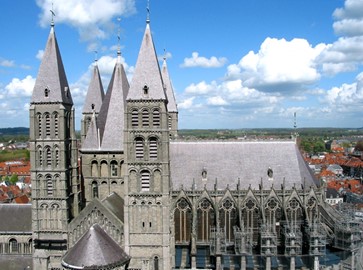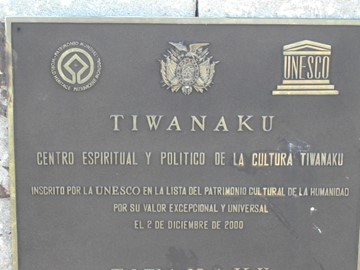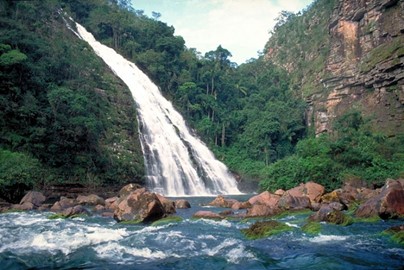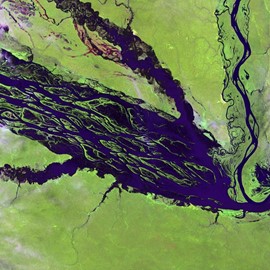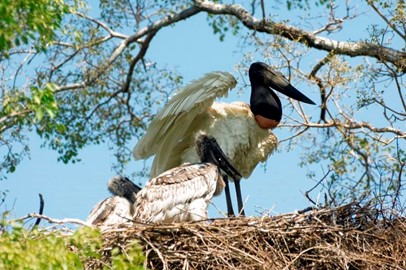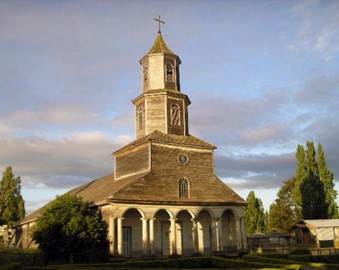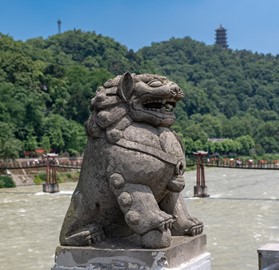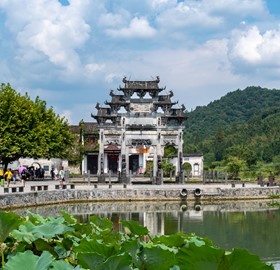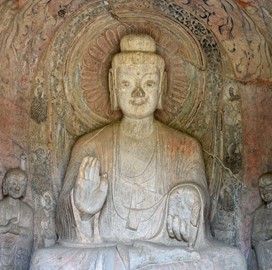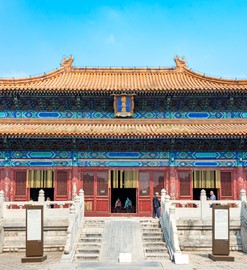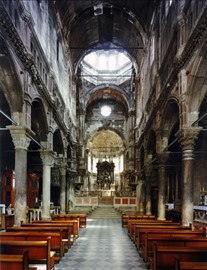search
Notre Dame Cathedral in Tournai
Notre-Dame Cathedral in Tournai, a UNESCO World Heritage site in Belgium, is a striking example of medieval architecture blending Romanesque and Gothic styles. Constructed primarily in the 12th and 13th centuries, it features a grand nave, five towers, and intricate stonework, reflecting its historical role as a religious and cultural landmark. Added to the UNESCO list in 2000, it stands out for its architectural evolution and artistic heritage. The cathedral remains a symbol of Belgium’s rich ecclesiastica... Read More
Tiwanaku
Tiwanaku, a UNESCO World Heritage site in Bolivia, is an ancient pre-Columbian archaeological site renowned for its monumental stone architecture and cultural legacy. Flourishing between 300 and 1000 CE, it features the iconic Gateway of the Sun, massive monoliths, and intricate carvings, reflecting the sophistication of the Tiwanaku civilization. Recognized by UNESCO in 2000, it offers insight into one of South America’s earliest urban societies. The site remains a powerful symbol of Bolivia’s indigenous h... Read More
Noel Kempff Mercado
The National Park is one of the largest (1,523,000 ha) and most intact parks in the Amazon Basin. With an altitudinal range of 200 m to nearly 1,000 m, it is the site of a rich mosaic of habitat types from Cerrado savannah and forest to upland evergreen Amazonian forests. The park boasts an evolutionary history dating back over a billion years to the Precambrian period. An estimated 4,000 species of flora as well as over 600 bird species and viable populations of many globally endangered or threatened verte... Read More
Central Amazon Conservation Complex
The Central Amazon Conservation Complex, a UNESCO World Heritage site in Brazil, is a vast protected region celebrated for its unparalleled Amazonian biodiversity. Covering millions of hectares, it includes rivers, forests, and wetlands teeming with species like pink river dolphins and giant arapaima fish. Inscribed by UNESCO in 2000, it’s one of the planet’s largest conservation areas. The complex stands as a vital testament to Brazil’s natural heritage.
Pantanal
The Pantanal Conservation Area, a UNESCO World Heritage site in Brazil, is a vast wetland renowned for its extraordinary wildlife and ecosystems. Spanning floodplains and rivers, it supports jaguars, caimans, and the world’s densest population of hyacinth macaws. Recognized by UNESCO in 2000, it’s a critical refuge for biodiversity in a seasonal landscape. The Pantanal remains a stunning showcase of Brazil’s natural wonders.
Churches of Chiloé
The Churches of Chiloé, a UNESCO World Heritage site in Chile, are a unique collection of 16 wooden churches built by Jesuit missionaries between the 17th and 19th centuries. Crafted without nails using local timber, these structures blend European architectural styles with Indigenous craftsmanship, reflecting the region’s cultural fusion. Recognized for their historical and artistic value, they stand as enduring symbols of faith and ingenuity.
Mount Qingcheng and the Dujiangyan
Mount Qingcheng and the Dujiangyan, a UNESCO World Heritage site in China, combine a sacred Taoist mountain with an ancient irrigation marvel. Mount Qingcheng’s lush peaks host historic temples, reflecting its status as a cradle of Taoism, while the Dujiangyan system, built over 2,000 years ago, showcases ingenious engineering that tamed floods and irrigated fields. Together, they represent a harmonious blend of nature, spirituality, and human innovation.
Xidi and Hongcun
Xidi and Hongcun, a UNESCO World Heritage site in China, are ancient villages renowned for their well-preserved Ming and Qing dynasty architecture. Featuring narrow lanes, whitewashed walls, and ornate wooden carvings, these settlements reflect the prosperity of merchant families. With serene ponds and surrounding hills, they offer a picturesque window into traditional Chinese rural life and cultural heritage.
Longmen Grottoes
The Longmen Grottoes, a UNESCO World Heritage site in China, are an extraordinary collection of Buddhist rock carvings etched into cliffs along a riverbank. Created between the 5th and 10th centuries, these thousands of statues and caves showcase intricate sculptures of deities and emperors, reflecting the peak of ancient Chinese artistry. This sacred site offers a profound testament to Buddhist devotion and cultural achievement.
Imperial Tombs
The Imperial Tombs of the Ming and Qing Dynasties, a UNESCO World Heritage site in China, are a collection of grand mausoleums honoring emperors of two dynasties. Featuring elaborate stone pathways, ornate statues, and majestic halls, these sites blend feng shui principles with stunning architecture. Set amidst serene landscapes, they reflect imperial reverence for ancestry and the afterlife, preserving centuries of royal legacy.
Cathedral of St James
The Cathedral of St. James, a UNESCO World Heritage site in Croatia, is a remarkable Romanesque monument completed in 1311 after over a century of construction. Built entirely from stone, it showcases intricate architectural details, including a distinctive dome and ornate portals adorned with sculptures by master craftsman Juraj Dalmatinac. The cathedral’s unique blend of Gothic and Renaissance elements reflects its historical evolution, making it a significant cultural and religious landmark. Today, it st... Read More
First Coffee Plantations
The First Coffee Plantations, a UNESCO World Heritage site in Cuba, are 19th-century ruins of estates that pioneered coffee production in the Americas. Nestled in lush hills, these sites feature remnants of manor houses, drying platforms, and slave quarters, reflecting the industry’s economic and social history. This landscape preserves a unique blend of agricultural heritage and natural beauty.
Holy Trinity Column in Olomouc
The Holy Trinity Column in Olomouc, a UNESCO World Heritage site in Czechia, is an ornate Baroque monument erected in the early 18th century to celebrate faith and resilience after the plague. Towering over a historic square, its intricate sculptures and golden details exemplify Central European artistry. This striking column stands as a testament to religious devotion and architectural skill.
Kronborg Castle
Kronborg Castle, a UNESCO World Heritage site in Denmark, is a magnificent Renaissance fortress renowned for its historical and cultural significance. Built in the late 16th century, it served as a strategic stronghold and royal residence, famously inspiring the setting of Shakespeare’s Hamlet. Its well-preserved architecture, including grand halls and intricate defenses, reflects Denmark’s rich heritage. Today, it attracts visitors with its captivating history and stunning coastal views.
Loire Valley
The Loire Valley, a UNESCO World Heritage site in France, is a picturesque region renowned for its Renaissance châteaux and lush landscapes. Its grand castles, like Chambord and Chenonceau, reflect the opulence of French royalty and architectural innovation. The valley’s vineyards and charming villages add to its scenic allure. This site embodies a harmonious blend of nature and human creativity. It offers a glimpse into France’s aristocratic past and cultural legacy. The Loire Valley stands as a testament ... Read More
Garden Kingdom of Dessau Wörlitz
The Garden Kingdom of Dessau-Wörlitz, a UNESCO World Heritage site in Germany, is an 18th-century landscape masterpiece blending nature and architecture. Designed as an Enlightenment-era retreat, it features elegant palaces, serene lakes, and meticulously planned gardens. This pioneering park reflects innovative landscaping ideas of its time. Its picturesque vistas and neoclassical structures draw visitors into a harmonious vision. The site offers a glimpse into aristocratic leisure and aesthetic ideals. It... Read More
Reichenau
Reichenau, a UNESCO World Heritage site in Germany, is an island renowned for its medieval monastic heritage from the 8th to 11th centuries. It features three well-preserved churches showcasing early Romanesque architecture and vibrant frescoes. Founded by St. Pirmin, the monastery became a key center of learning and manuscript production. Set in a serene lake landscape, it reflects the Carolingian era’s cultural and spiritual influence. This site offers a glimpse into Europe’s early medieval history. Its p... Read More
Pécs Necropolis
The Pécs Necropolis is an early Christian burial site recognized for its remarkable 4th-century tombs, adorned with intricate frescoes depicting biblical scenes and symbols of faith. This UNESCO World Heritage Site showcases the artistic and architectural sophistication of a community embracing Christianity during the Roman Empire. It offers a glimpse into the spiritual and cultural life of the era.
Verona
Verona, a UNESCO World Heritage site in Italy, is a historic city renowned for its well-preserved Roman and medieval architecture. Highlights include the ancient Roman Arena, still used for performances, and the picturesque Ponte Pietra bridge spanning the Adige River. Its charming streets, lined with elegant palaces and churches, reflect a rich cultural heritage shaped by centuries of artistic and historical development.
Isole Eolie
Isole Eolie, a UNESCO World Heritage site in Italy, comprises a volcanic archipelago renowned for its dramatic landscapes and geological significance. This cluster of islands features active volcanoes, such as Stromboli and Vulcano, alongside rugged coastlines, thermal springs, and crystalline waters. Valued for its natural beauty and scientific importance, it offers insights into volcanic processes and Mediterranean ecosystems shaped over millennia.
Assisi
Assisi, a UNESCO World Heritage site in Italy, is a medieval hilltop town renowned for its historical and spiritual significance. It is celebrated as the birthplace of St. Francis, featuring the impressive Basilica of San Francesco with its stunning frescoes and Gothic architecture. The site preserves a harmonious blend of art, culture, and religion, reflecting centuries of pilgrimage and architectural evolution in a picturesque setting.
Gusuku Sites
The Gusuku Sites, a UNESCO World Heritage site in Japan, represent a unique collection of castles, sacred sites, and archaeological remains from the Ryukyu Kingdom. These stone-walled fortresses, including the iconic Shuri Castle, highlight a distinctive blend of Japanese and Chinese architectural influences. Recognized for their historical and cultural value, they illustrate the kingdom’s medieval social structure and spiritual traditions.
Kinabalu Park
Kinabalu Park, a UNESCO World Heritage site in Malaysia, is renowned for its rich biodiversity and stunning landscapes. Home to Mount Kinabalu, Southeast Asia’s highest peak, the park boasts over 4,500 species of flora and fauna, including rare orchids and the carnivorous pitcher plant. Established in 1964, it serves as a vital conservation area and a popular destination for ecotourism, offering visitors a chance to explore its unique ecosystems and natural beauty.
Gunung Mulu
Gunung Mulu, a UNESCO World Heritage site in Malaysia, is renowned for its exceptional biodiversity and stunning geological formations. This national park features vast limestone caves, including the world’s largest cave chamber, and dense rainforests teeming with unique flora and fauna. Its dramatic peaks, deep gorges, and hidden underground rivers make it a globally significant natural wonder, attracting researchers and adventurers alike.
Rietveld Schröder House
The Rietveld Schröder House, a UNESCO World Heritage site in the Netherlands, is an iconic example of De Stijl architecture, designed by Gerrit Rietveld in 1924. Commissioned by Truus Schröder, it features a revolutionary open-plan design with movable walls, emphasizing functionality, simplicity, and abstract geometric forms. Its use of primary colors and clean lines reflects the artistic principles of the De Stijl movement, pioneered by Piet Mondrian. The house stands as a testament to innovative modernist... Read More
